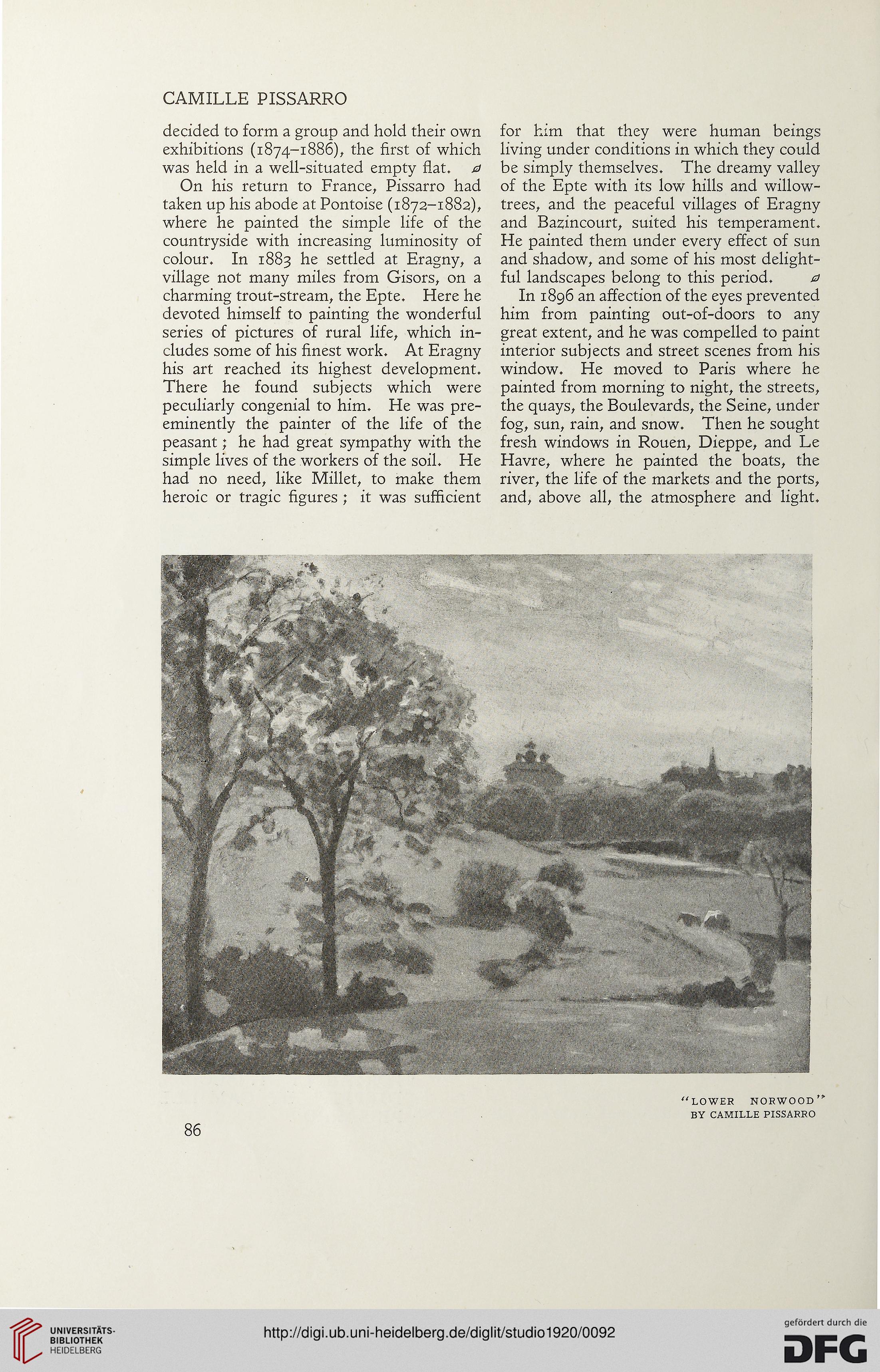CAMILLE PISSARRO
decided to form a group and hold their own
exhibitions (1874-1886), the first of which
was held in a well-situated empty flat, a
On his return to France, Pissarro had
taken up his abode at Pontoise (1872-1882),
where he painted the simple life of the
countryside with increasing luminosity of
colour. In 1883 he settled at Eragny, a
village not many miles from Gisors, on a
charming trout-stream, the Epte. Here he
devoted himself to painting the wonderful
series of pictures of rural life, which in-
cludes some of his finest work. At Eragny
his art reached its highest development.
There he found subjects which were
peculiarly congenial to him. He was pre-
eminently the painter of the life of the
peasant; he had great sympathy with the
simple lives of the workers of the soil. He
had no need, like Millet, to make them
heroic or tragic figures ; it was sufficient
for him that they were human beings
living under conditions in which they could
be simply themselves. The dreamy valley
of the Epte with its low hills and willow-
trees, and the peaceful villages of Eragny
and Bazincourt, suited his temperament.
He painted them under every effect of sun
and shadow, and some of his most delight-
ful landscapes belong to this period. a
In 1896 an affection of the eyes prevented
him from painting out-of-doors to any
great extent, and he was compelled to paint
interior subjects and street scenes from his
window. He moved to Paris where he
painted from morning to night, the streets,
the quays, the Boulevards, the Seine, under
fog, sun, rain, and snow. Then he sought
fresh windows in Rouen, Dieppe, and Le
Havre, where he painted the boats, the
river, the life of the markets and the ports,
and, above all, the atmosphere and light.
86
“ LOWER NORWOOD’”
BY CAMILLE PISSARRO
decided to form a group and hold their own
exhibitions (1874-1886), the first of which
was held in a well-situated empty flat, a
On his return to France, Pissarro had
taken up his abode at Pontoise (1872-1882),
where he painted the simple life of the
countryside with increasing luminosity of
colour. In 1883 he settled at Eragny, a
village not many miles from Gisors, on a
charming trout-stream, the Epte. Here he
devoted himself to painting the wonderful
series of pictures of rural life, which in-
cludes some of his finest work. At Eragny
his art reached its highest development.
There he found subjects which were
peculiarly congenial to him. He was pre-
eminently the painter of the life of the
peasant; he had great sympathy with the
simple lives of the workers of the soil. He
had no need, like Millet, to make them
heroic or tragic figures ; it was sufficient
for him that they were human beings
living under conditions in which they could
be simply themselves. The dreamy valley
of the Epte with its low hills and willow-
trees, and the peaceful villages of Eragny
and Bazincourt, suited his temperament.
He painted them under every effect of sun
and shadow, and some of his most delight-
ful landscapes belong to this period. a
In 1896 an affection of the eyes prevented
him from painting out-of-doors to any
great extent, and he was compelled to paint
interior subjects and street scenes from his
window. He moved to Paris where he
painted from morning to night, the streets,
the quays, the Boulevards, the Seine, under
fog, sun, rain, and snow. Then he sought
fresh windows in Rouen, Dieppe, and Le
Havre, where he painted the boats, the
river, the life of the markets and the ports,
and, above all, the atmosphere and light.
86
“ LOWER NORWOOD’”
BY CAMILLE PISSARRO




